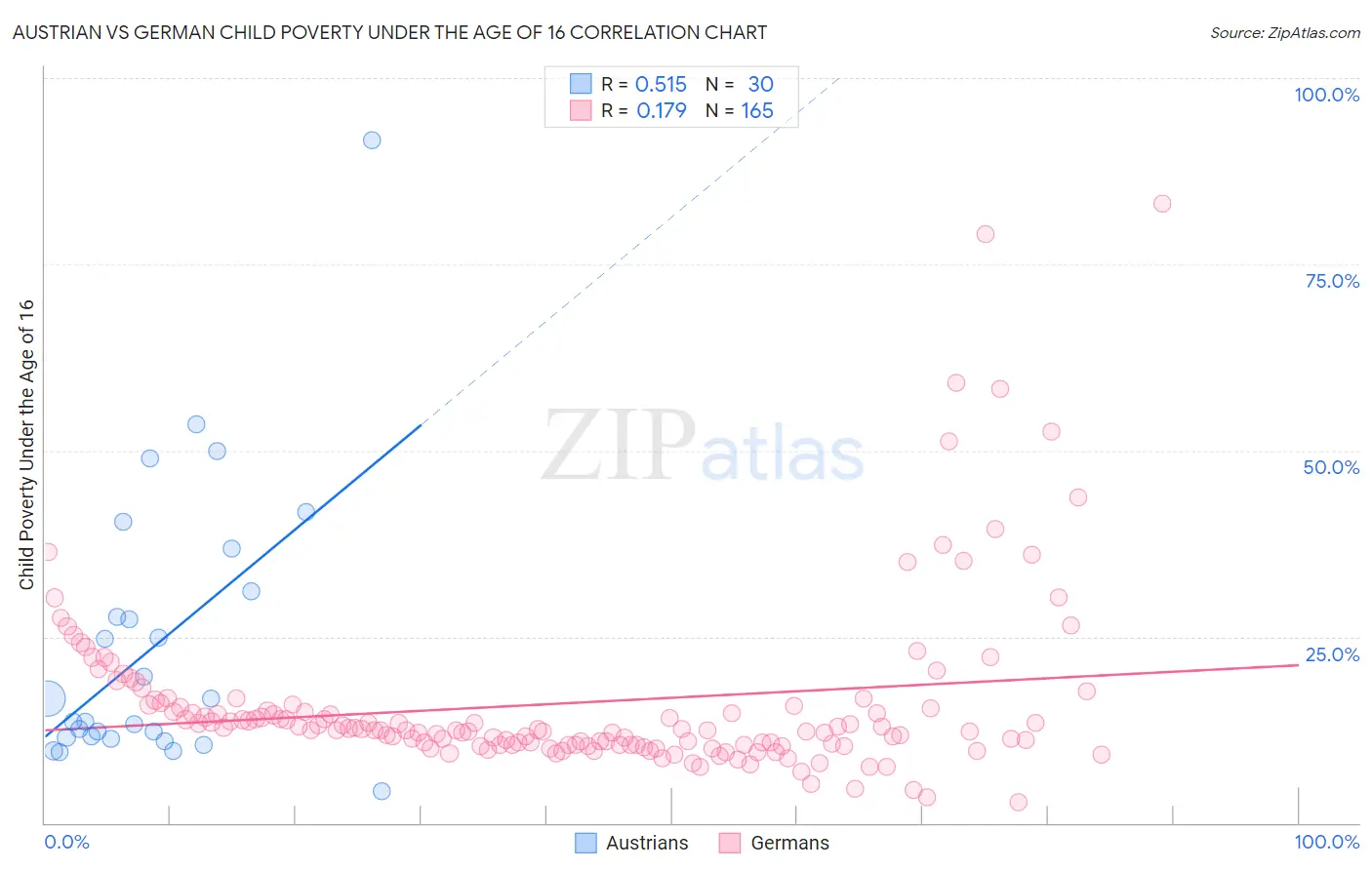Austrian vs German Child Poverty Under the Age of 16
COMPARE
Austrian
German
Child Poverty Under the Age of 16
Child Poverty Under the Age of 16 Comparison
Austrians
Germans
14.5%
CHILD POVERTY UNDER THE AGE OF 16
96.9/ 100
METRIC RATING
90th/ 347
METRIC RANK
14.5%
CHILD POVERTY UNDER THE AGE OF 16
96.9/ 100
METRIC RATING
89th/ 347
METRIC RANK
Austrian vs German Child Poverty Under the Age of 16 Correlation Chart
The statistical analysis conducted on geographies consisting of 445,410,621 people shows a substantial positive correlation between the proportion of Austrians and poverty level among children under the age of 16 in the United States with a correlation coefficient (R) of 0.515 and weighted average of 14.5%. Similarly, the statistical analysis conducted on geographies consisting of 566,271,937 people shows a poor positive correlation between the proportion of Germans and poverty level among children under the age of 16 in the United States with a correlation coefficient (R) of 0.179 and weighted average of 14.5%, a difference of 0.060%.

Child Poverty Under the Age of 16 Correlation Summary
| Measurement | Austrian | German |
| Minimum | 4.3% | 2.8% |
| Maximum | 91.7% | 83.1% |
| Range | 87.4% | 80.4% |
| Mean | 23.9% | 16.1% |
| Median | 15.1% | 12.5% |
| Interquartile 25% (IQ1) | 11.5% | 10.4% |
| Interquartile 75% (IQ3) | 31.1% | 15.8% |
| Interquartile Range (IQR) | 19.6% | 5.4% |
| Standard Deviation (Sample) | 18.8% | 11.8% |
| Standard Deviation (Population) | 18.5% | 11.7% |
Demographics Similar to Austrians and Germans by Child Poverty Under the Age of 16
In terms of child poverty under the age of 16, the demographic groups most similar to Austrians are Northern European (14.5%, a difference of 0.12%), Immigrants from North America (14.6%, a difference of 0.18%), Immigrants from Italy (14.6%, a difference of 0.21%), Immigrants from Argentina (14.5%, a difference of 0.22%), and Taiwanese (14.5%, a difference of 0.22%). Similarly, the demographic groups most similar to Germans are Northern European (14.5%, a difference of 0.050%), Taiwanese (14.5%, a difference of 0.15%), Immigrants from Argentina (14.5%, a difference of 0.16%), Soviet Union (14.5%, a difference of 0.23%), and Immigrants from North America (14.6%, a difference of 0.25%).
| Demographics | Rating | Rank | Child Poverty Under the Age of 16 |
| Swiss | 97.3 /100 | #79 | Exceptional 14.5% |
| Immigrants | North Macedonia | 97.2 /100 | #80 | Exceptional 14.5% |
| Finns | 97.2 /100 | #81 | Exceptional 14.5% |
| Immigrants | Canada | 97.2 /100 | #82 | Exceptional 14.5% |
| Egyptians | 97.2 /100 | #83 | Exceptional 14.5% |
| Immigrants | Latvia | 97.1 /100 | #84 | Exceptional 14.5% |
| Soviet Union | 97.1 /100 | #85 | Exceptional 14.5% |
| Immigrants | Argentina | 97.1 /100 | #86 | Exceptional 14.5% |
| Taiwanese | 97.1 /100 | #87 | Exceptional 14.5% |
| Northern Europeans | 97.0 /100 | #88 | Exceptional 14.5% |
| Germans | 96.9 /100 | #89 | Exceptional 14.5% |
| Austrians | 96.9 /100 | #90 | Exceptional 14.5% |
| Immigrants | North America | 96.7 /100 | #91 | Exceptional 14.6% |
| Immigrants | Italy | 96.7 /100 | #92 | Exceptional 14.6% |
| Argentineans | 96.6 /100 | #93 | Exceptional 14.6% |
| Immigrants | South Africa | 96.3 /100 | #94 | Exceptional 14.6% |
| Immigrants | Croatia | 96.1 /100 | #95 | Exceptional 14.6% |
| Immigrants | France | 95.8 /100 | #96 | Exceptional 14.7% |
| Paraguayans | 95.7 /100 | #97 | Exceptional 14.7% |
| Immigrants | Belarus | 95.7 /100 | #98 | Exceptional 14.7% |
| British | 95.5 /100 | #99 | Exceptional 14.7% |